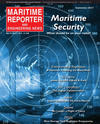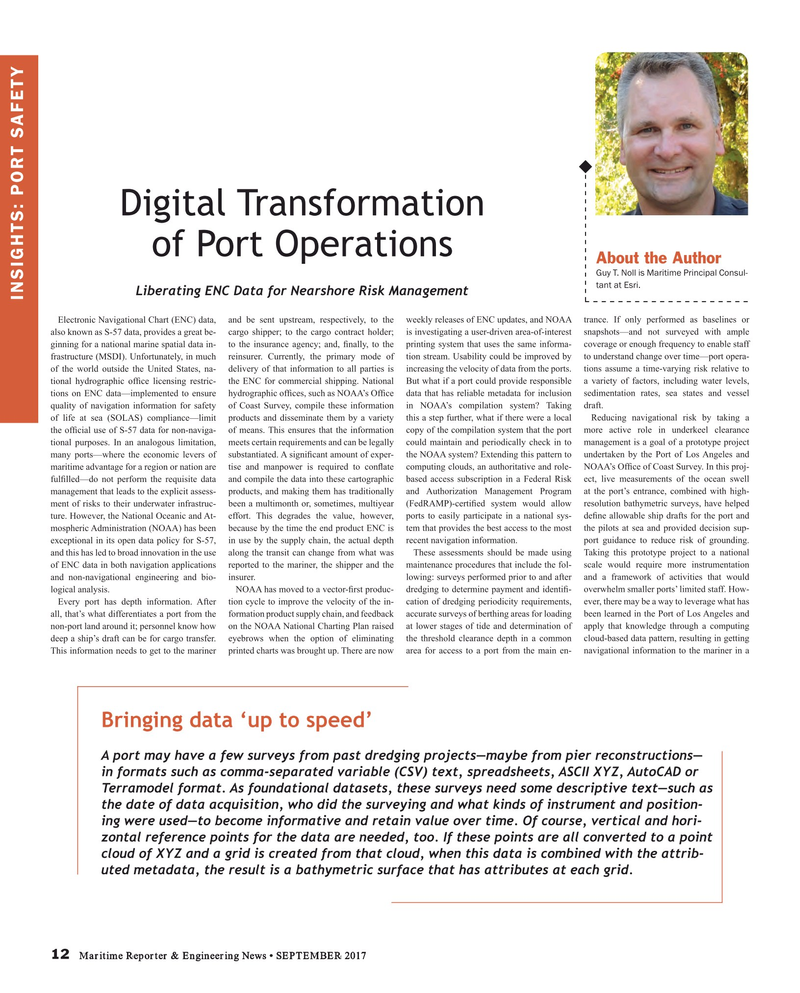
Page 12: of Maritime Reporter Magazine (September 2017)
U.S. Navy Quarterly
Read this page in Pdf, Flash or Html5 edition of September 2017 Maritime Reporter Magazine
Digital Transformation of Port Operations
About the Author
Guy T. Noll is Maritime Principal Consul- tant at Esri.
Liberating ENC Data for Nearshore Risk Management
INSIGHTS: PORT SAFETY
Electronic Navigational Chart (ENC) data, and be sent upstream, respectively, to the weekly releases of ENC updates, and NOAA trance. If only performed as baselines or also known as S-57 data, provides a great be- cargo shipper; to the cargo contract holder; is investigating a user-driven area-of-interest snapshots—and not surveyed with ample ginning for a national marine spatial data in- to the insurance agency; and, ? nally, to the printing system that uses the same informa- coverage or enough frequency to enable staff frastructure (MSDI). Unfortunately, in much reinsurer. Currently, the primary mode of tion stream. Usability could be improved by to understand change over time—port opera- of the world outside the United States, na- delivery of that information to all parties is increasing the velocity of data from the ports. tions assume a time-varying risk relative to tional hydrographic of? ce licensing restric- the ENC for commercial shipping. National But what if a port could provide responsible a variety of factors, including water levels, tions on ENC data—implemented to ensure hydrographic of? ces, such as NOAA’s Of? ce data that has reliable metadata for inclusion sedimentation rates, sea states and vessel quality of navigation information for safety of Coast Survey, compile these information in NOAA’s compilation system? Taking draft. of life at sea (SOLAS) compliance—limit products and disseminate them by a variety this a step further, what if there were a local Reducing navigational risk by taking a the of? cial use of S-57 data for non-naviga- of means. This ensures that the information copy of the compilation system that the port more active role in underkeel clearance tional purposes. In an analogous limitation, meets certain requirements and can be legally could maintain and periodically check in to management is a goal of a prototype project many ports—where the economic levers of substantiated. A signi? cant amount of exper- the NOAA system? Extending this pattern to undertaken by the Port of Los Angeles and maritime advantage for a region or nation are tise and manpower is required to con? ate computing clouds, an authoritative and role- NOAA’s Of? ce of Coast Survey. In this proj- ful? lled—do not perform the requisite data and compile the data into these cartographic based access subscription in a Federal Risk ect, live measurements of the ocean swell management that leads to the explicit assess- products, and making them has traditionally and Authorization Management Program at the port’s entrance, combined with high- ment of risks to their underwater infrastruc- been a multimonth or, sometimes, multiyear (FedRAMP)-certi? ed system would allow resolution bathymetric surveys, have helped ture. However, the National Oceanic and At- effort. This degrades the value, however, ports to easily participate in a national sys- de? ne allowable ship drafts for the port and mospheric Administration (NOAA) has been because by the time the end product ENC is tem that provides the best access to the most the pilots at sea and provided decision sup- exceptional in its open data policy for S-57, in use by the supply chain, the actual depth recent navigation information. port guidance to reduce risk of grounding. and this has led to broad innovation in the use along the transit can change from what was These assessments should be made using Taking this prototype project to a national of ENC data in both navigation applications reported to the mariner, the shipper and the maintenance procedures that include the fol- scale would require more instrumentation and non-navigational engineering and bio- insurer. lowing: surveys performed prior to and after and a framework of activities that would logical analysis. NOAA has moved to a vector-? rst produc- dredging to determine payment and identi? - overwhelm smaller ports’ limited staff. How-
Every port has depth information. After tion cycle to improve the velocity of the in- cation of dredging periodicity requirements, ever, there may be a way to leverage what has all, that’s what differentiates a port from the formation product supply chain, and feedback accurate surveys of berthing areas for loading been learned in the Port of Los Angeles and non-port land around it; personnel know how on the NOAA National Charting Plan raised at lower stages of tide and determination of apply that knowledge through a computing deep a ship’s draft can be for cargo transfer. eyebrows when the option of eliminating the threshold clearance depth in a common cloud-based data pattern, resulting in getting
This information needs to get to the mariner printed charts was brought up. There are now area for access to a port from the main en- navigational information to the mariner in a
Bringing data ‘up to speed’
A port may have a few surveys from past dredging projects—maybe from pier reconstructions— in formats such as comma-separated variable (CSV) text, spreadsheets, ASCII XYZ, AutoCAD or
Terramodel format. As foundational datasets, these surveys need some descriptive text—such as the date of data acquisition, who did the surveying and what kinds of instrument and position- ing were used—to become informative and retain value over time. Of course, vertical and hori- zontal reference points for the data are needed, too. If these points are all converted to a point cloud of XYZ and a grid is created from that cloud, when this data is combined with the attrib- uted metadata, the result is a bathymetric surface that has attributes at each grid.
12 Maritime Reporter & Engineering News • SEPTEMBER 2017
MR #9 (10-17).indd 12 MR #9 (10-17).indd 12 9/6/2017 9:54:38 AM9/6/2017 9:54:38 AM

 11
11

 13
13
